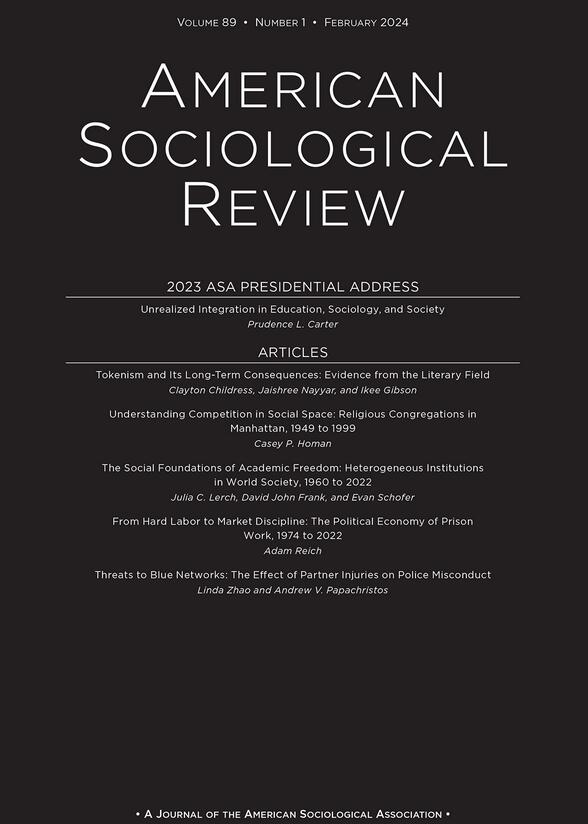Consolidated Advantage: New Organizational Dynamics of Wage Inequality
IF 6.2
1区 社会学
Q1 SOCIOLOGY
引用次数: 18
Abstract
The two main axes of inequality in the U.S. labor market—occupation and workplace—have increasingly consolidated. In 1999, the largest share of employment at high-paying workplaces was blue-collar production workers, but by 2017 it was managers and professionals. As such, workers benefiting from a high-paying workplace are increasingly those who already benefit from membership in a high-paying occupation. Drawing on occupation-by-workplace data, we show that up to two-thirds of the rise in wage inequality since 1999 can be accounted for not by occupation or workplace inequality alone, but by this increased consolidation. Consolidation is not primarily due to outsourcing or to occupations shifting across a fixed set of workplaces. Instead, consolidation has resulted from new bases of workplace pay premiums. Workplace premiums associated with teams of professionals have increased, while premiums for previously high-paid blue-collar workers have been cut. Yet the largest source of consolidation is bifurcation in the social sector, whereby some previously low-paying but high-professional share workplaces, like hospitals and schools, have deskilled their jobs, while others have raised pay. Broadly, the results demonstrate an understudied way that organizations affect wage inequality: not by directly increasing variability in workplace or occupation premiums, but by consolidating these two sources of inequality.整合优势:工资不平等的新组织动力学
美国劳动力市场不平等的两个主要轴心——职业和工作场所——已经日益巩固。1999年,高薪工作场所的最大就业份额是蓝领生产工人,但到2017年,这一比例变为管理人员和专业人员。因此,从高薪工作场所受益的工人越来越多是那些已经从高薪职业的会员资格中受益的人。根据按职业划分的工作场所数据,我们发现,自1999年以来,高达三分之二的工资不平等上升,不仅可以归咎于职业或工作场所的不平等,还可以归咎于这种日益加剧的整合。整合主要不是由于外包或职业在固定工作场所的转移。相反,合并源于新的职场薪酬溢价基数。与专业团队相关的工作场所保费增加了,而以前高薪的蓝领工人的保费却被削减了。然而,整合的最大来源是社会部门的分化,一些以前低工资但高专业的工作场所,如医院和学校,已经降低了他们的工作技能,而另一些则提高了工资。总的来说,研究结果表明,组织影响工资不平等的方式尚未得到充分研究:不是通过直接增加工作场所或职业溢价的可变性,而是通过巩固这两个不平等来源。
本文章由计算机程序翻译,如有差异,请以英文原文为准。
求助全文
约1分钟内获得全文
求助全文
来源期刊

American Sociological Review
SOCIOLOGY-
CiteScore
13.30
自引率
3.30%
发文量
35
期刊介绍:
The American Sociological Association (ASA) is a non-profit membership association established in 1905. Its mission is to advance sociology as a scientific discipline and profession that serves the public good. ASA is comprised of approximately 12,000 members including faculty members, researchers, practitioners, and students in the field of sociology. Roughly 20% of the members work in government, business, or non-profit organizations.
One of ASA's primary endeavors is the publication and dissemination of important sociological research. To this end, they founded the American Sociological Review (ASR) in 1936. ASR is the flagship journal of the association and publishes original works that are of general interest and contribute to the advancement of sociology. The journal seeks to publish new theoretical developments, research results that enhance our understanding of fundamental social processes, and significant methodological innovations. ASR welcomes submissions from all areas of sociology, placing an emphasis on exceptional quality.
Aside from ASR, ASA also publishes 14 professional journals and magazines. Additionally, they organize an annual meeting that attracts over 6,000 participants. ASA's membership consists of scholars, professionals, and students dedicated to the study and application of sociology in various domains of society.
 求助内容:
求助内容: 应助结果提醒方式:
应助结果提醒方式:


